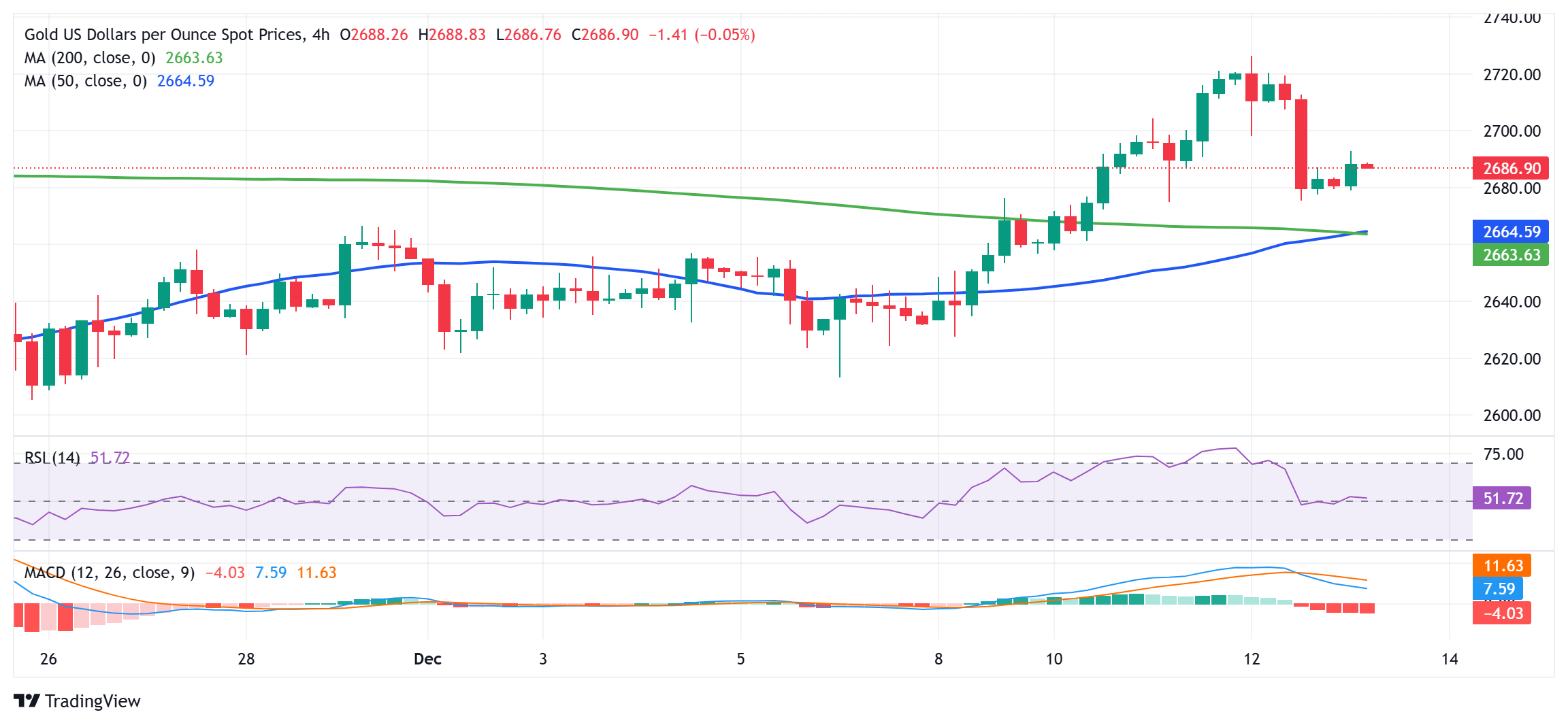- Gold price regains positive traction after Thursday’s pullback from a multi-month high.
- Geopolitical risks, trade war fears and Fed rate cut expectations continue to benefit the commodity.
- Expectations of a less dovish Fed and elevated US bond yields could limit the precious metal.
The price of Gold (XAU/USD) attracts some buyers during the Asian session on Friday and reverses some of the previous day’s profit-taking decline from a five-week high, around the $2,726 area. Geopolitical risks arising from the war between Russia and Ukraine and tensions in the Middle East, along with concerns over US President-elect Donald Trump’s tariff plans, continue to drive safe haven demand. In addition to this, the growing market conviction that the Federal Reserve (Fed) will make a third consecutive rate cut at the end of the December monetary policy meeting next week turns out to be a key factor benefiting the non-yielding yellow metal.
Meanwhile, signs that progress in reducing inflation to the Fed’s 2% target has stalled suggest the U.S. central bank will take a more cautious stance toward lowering interest rates. . This continues to support elevated US Treasury yields and continues to act as a tailwind for the US Dollar (USD), which could, in turn, cap gold price gains. Traders They could also refrain from placing aggressive bets and choose to wait for the outcome of the FOM meeting next week. Investors will look for clues on the Fed’s rate cut path to determine the next directional move for the dollar and the precious metal.
Gold price gets some support from safe haven flows; upside potential appears limited
- Ukraine has launched missiles supplied by the US, targeting strategic sites in Russian territory. Meanwhile, Russian forces are approaching the key city of Pokrovsk in eastern Ukraine after intense fighting for a month.
- Israel said on Thursday that its army would remain in the Syrian territory it occupied until a new force was established to meet its security demands and fill the vacuum after the collapse of the Syrian regime.
- This marks a significant escalation in geopolitical tensions and directs some safe-haven flows to the price of Gold amid bets that the Federal Reserve will reduce borrowing costs at the end of the December meeting.
- In the absence of a major bullish surprise in the latest US consumer inflation figures released on Wednesday, markets appear to have fully priced in a 25 basis point rate cut from the Fed next week.
- The US Bureau of Labor Statistics reported Thursday that the headline Producer Price Index (PPI) rose 0.4% in November and the annual rate accelerated from 2.6% in October to 3% during the reported month.
- The annual core PPI rose 0.2% in November to 3.4% compared to the same period last year, beating estimates and indicating progress in reducing inflation to the 2% target. has stagnated.
- This adds to expectations that US President Donald Trump’s expansionary policies will boost inflation and suggests the Fed will take a more cautious stance on lowering interest rates in the future.
- Expectations of a less dovish Fed continue to boost US Treasury yields and help the US Dollar preserve its weekly gains to a new monthly high, which could cap the lower-yielding yellow metal.
- Investors are looking forward to the crucial FOMC monetary policy decision next week for clues on the US interest rate outlook. This will boost demand for USD and provide a significant boost to the XAU/USD.
Gold price needs to break above $2,726 for bulls to maintain control in the short term
From a technical perspective, any additional strength above the $2,700 level will likely face resistance near the $2,725-26 region or the monthly high reached on Thursday. The next move higher could take the price of Gold to the intermediate barrier of $2,735 en route towards the resistance zone of $2,748-2,750. The next relevant barrier lies near the $2,775 region, above which the bulls could aim to challenge the all-time high, around the $2,800 neighborhood reached in October.
On the downside, the $2,675-2,674 area appears to have emerged as immediate strong support. A convincing break below, however, could spark some technical selling and pave the way for further losses towards the $2,658-2,656 confluence – which comprises the 50- and 200-period SMA on the 4-hour chart. . The latter should act as a key pivot point, which if broken decisively could make the Gold price vulnerable to weakening further towards the $2,632-2,630 area en route towards the round $2,600 level.
Gold FAQs
Gold has played a fundamental role in human history, as it has been widely used as a store of value and medium of exchange. Today, apart from its brilliance and use for jewelry, the precious metal is considered a safe-haven asset, meaning it is considered a good investment in turbulent times. Gold is also considered a hedge against inflation and currency depreciation, since it does not depend on any specific issuer or government.
Central banks are the largest holders of Gold. In their aim to support their currencies in turbulent times, central banks tend to diversify their reserves and purchase Gold to improve the perception of strength of the economy and currency. High Gold reserves can be a source of confidence for the solvency of a country. Central banks added 1,136 tons of gold worth about $70 billion to their reserves in 2022, according to data from the World Gold Council. This is the largest annual purchase since records exist. Central banks in emerging economies such as China, India and Türkiye are rapidly increasing their gold reserves.
Gold has an inverse correlation with the US Dollar and US Treasuries, which are the main reserve and safe haven assets. When the Dollar depreciates, the price of Gold tends to rise, allowing investors and central banks to diversify their assets in turbulent times. Gold is also inversely correlated with risk assets. A rally in the stock market tends to weaken the price of Gold, while sell-offs in riskier markets tend to favor the precious metal.
The price of Gold can move due to a wide range of factors. Geopolitical instability or fear of a deep recession can cause the price of Gold to rise rapidly due to its status as a safe haven asset. As a non-yielding asset, the price of Gold tends to rise when interest rates fall, while rising money prices tend to weigh down the yellow metal. Still, most of the moves depend on how the US Dollar (USD) performs, as the asset is traded in dollars (XAU/USD). A strong Dollar tends to keep the price of Gold in check, while a weaker Dollar is likely to push up Gold prices.
Source: Fx Street
I am Joshua Winder, a senior-level journalist and editor at World Stock Market. I specialize in covering news related to the stock market and economic trends. With more than 8 years of experience in this field, I have become an expert in financial reporting.








